Disabling Red Eye Reduction on iPhone: A Comprehensive Guide
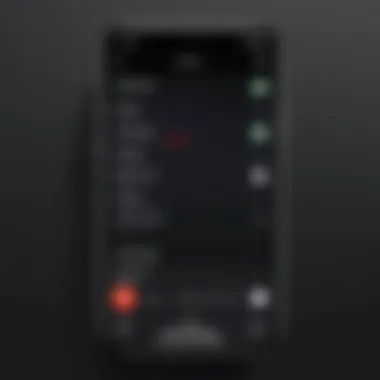
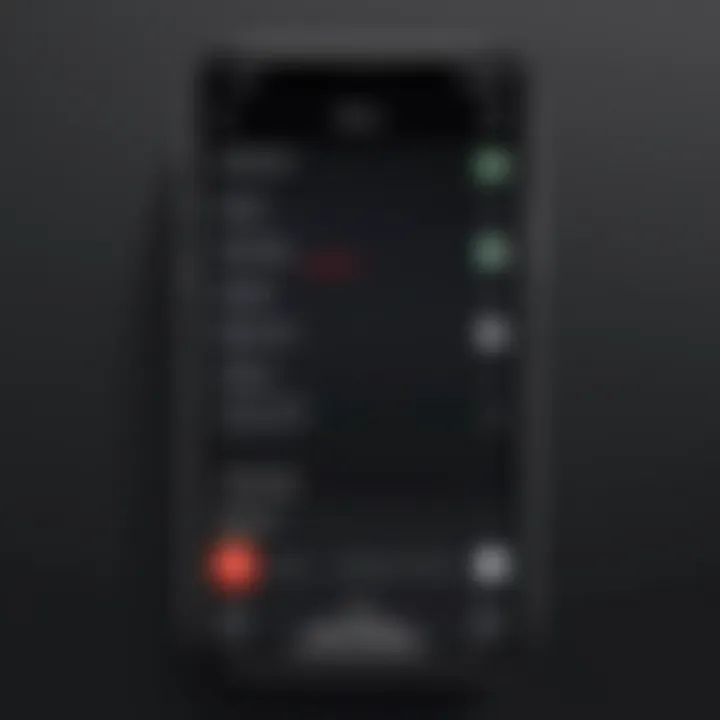
Intro
The red-eye reduction feature on iPhones has been a point of contention among photographers for years. While its intent is to improve photo quality, many users find it can lead to less desired outcomes in certain scenarios. Understanding how to disable this feature is crucial for those who wish to have full control over their photographic results. This guide aims to walk you through the process in detail, ensuring that you can take stunning photographs without the distractions of red-eye issues.
Photographic quality is often about the subtleties. Disabling this automatic function may be the difference between a captivating portrait and a less appealing one. Furthermore, as photography technology evolves, options for customization increase, providing users with a variety of enhancements to explore. This guide is designed to address different iPhone models and settings, considering both novice and advanced users.
As we delve deeper into the specifics in upcoming sections, remember that your personal preferences will greatly influence these choices. Red-eye reduction may suit some situations, while other times, its elimination may yield more natural results. Thus, finding a balance is essential.
Understanding Red Eye Reduction
Understanding red eye reduction is critical for optimizing the use of the iPhone camera. Many users encounter the red eye effect during photography sessions, particularly in low-light situations. This phenomenon occurs when the camera's flash reflects off the retina at the back of the eye, leading to an unattractive red glare in portraits.
The purpose of red eye reduction is to mitigate this issue. By preemptively addressing potential red eye occurrences, users can enhance the quality of their photos and avoid post-capture editing.
In addition, understanding the settings available for red eye reduction can allow users to tailor their photography experience. It can also factor into composition strategies, especially for group photos or candid shots where lighting conditions may not be ideal.
The Purpose of Red Eye Reduction
Red eye reduction primarily serves a practical function in photography. It is designed to minimize red eye during photography, particularly in environments where the use of flash may be necessary. The technique utilizes a series of brief pre-flashes to constrict the pupils of subjects' eyes. This response occurs because the human eye instinctively reacts to bright lights.
This process not only reduces the likelihood of capturing red eye but also creates clearer, more professional-looking photographs. Users who understand how red eye reduction works can make informed decisions about whether to enable or disable this feature based on their unique shooting conditions.
Common Scenarios for Red Eye Occurrences
Red eye is a common issue, especially in certain scenarios, such as:
- Low Light Environments: When there is insufficient ambient light, users often rely on the flash, increasing the potential for red eye.
- Close-Up Shots: Taking pictures from close distances can also enhance the likelihood of red eye development, as the flash is more directed towards the subject's eyes.
- Subjects with Bright Eyes: People with lighter-colored irises may be more affected by red eye due to the reflection of light in their retinas.
Each of these scenarios can significantly impact the final image. By understanding these situations, users can proactively adjust their camera settings or release the shutter at times when red eye is less likely to occur.
"Awareness of red eye contributing factors not only enhances photo quality but also enables photographers to develop more adaptive techniques."
In summary, becoming well-versed in red eye reduction is necessary for anyone looking to maximize their iPhone's photographic potential. The following sections will delve into the specifics of managing red eye settings across different iPhone models.
Prevalence of Red Eye in iPhone Photography
Understanding the prevalence of red eye in iPhone photography is crucial. This issue is not merely cosmetic; it has practical implications for both personal and professional photography. Red eye occurs when light from the camera's flash reflects off the retina. This is particularly noticeable in low-light situations. Since many iPhone users rely on their devices for capturing spontaneous moments, it is vital to address this concern so that it does not detract from the quality of their images.
Several factors lead to the occurrence of red eye when using an iPhone. The type of lighting and flash position can play significant roles. Awareness of these factors can help users anticipate and manage the phenomenon effectively. Utilization of the camera’s red-eye reduction can be an immediate measure, though in some cases users may prefer to disable this feature for varying reasons, including artistic preferences or technical adjustments.
In general, users report frustration when red eye appears unexpectedly, especially in cherished family photos or significant events. Therefore, knowing how to handle this issue can enhance the photographic experience greatly.
Factors Contributing to Red Eye on iPhones
Iphones, like all cameras, are subject to certain conditions that nurture red eye. One of the primary reasons is the brightness and type of flash. The iPhone uses a built-in flash that can create direct light exposure in dim environments. Additionally, the distance between the subject and the camera contributes to this effect. If a flash illuminates a subject's face too directly, it can easily result in red eye.
Furthermore, the position of the camera relative to the subject's line of sight can affect how light reflects off the retina. The characteristics of the person being photographed also matter; for instance, those with lighter eyes may be more prone to experiencing red eye.
To summarize, understanding these elements allows photographers to take intelligent measures to reduce the chances of red eye in their images. Experimenting with distance, angle, and lighting can yield better results.
Impact of Lighting Conditions

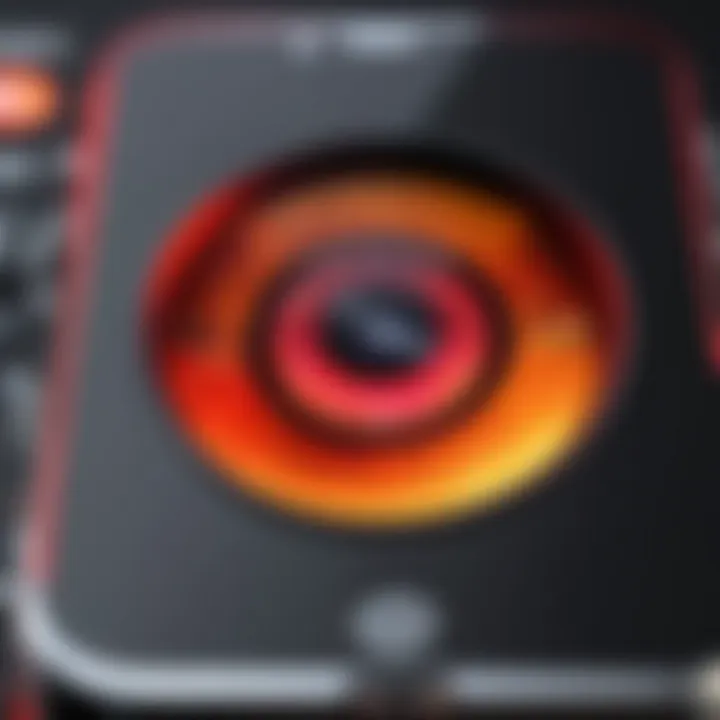
Lighting conditions significantly influence the likelihood of red eye in photography. Low-light situations are often culprits, as the flash compensates for the lack of ambient light. In these instances, any reflection of the flash can become pronounced. Users should consider alternative lighting sources, if available, as this can dramatically reduce red eye effects.
Moreover, mixed lighting environments—where natural light intersects with artificial light—can create complicated scenarios. Here, the iPhone's automatic settings may not adjust correctly, leading to unexpected photo outcomes. In such cases, manual adjustments can be beneficial.
Understanding these dynamics enables iPhone users to approach photography with a refined strategy, enhancing both their skills and enjoyment of the medium.
Navigating iPhone Camera Settings
Effective photography hinges on a clear understanding of the available settings within the iPhone camera app. Knowing how to navigate these settings not only enhances your photographic experience but also empowers you to make informed decisions regarding how your photos are captured. Disabling the red-eye reduction feature is just one aspect of this. Familiarizing yourself with the camera settings can streamline the process of adjusting various attributes such as exposure, focus, and color balance. Each adjustment can have a notable impact on the overall quality of your images, allowing for more creativity and control.
Accessing the Camera App
To begin, launching the camera app is essential. This action may seem trivial, but it is the gateway to accessing various features. Simply find the camera icon on your home screen or swipe left from the lock screen to open it swiftly. This direct approach can save valuable time when you want to capture spontaneous moments.
Upon entering the app, the sight is straightforward, with primary options prominently displayed. You will typically see modes such as Photo, Video, Portrait, and more. These choices allow you to select how you wish to capture your surroundings. Accessing the settings specific to capturing photos requires a slight shift in focus from shooting to adjustment.
Identifying Settings for Photo Capture
Once inside the camera app, locating settings tailored for photo capture becomes vital. Notably, tap on the small arrow or the icon that appears above the shutter button. This action brings up a menu showcasing various options. You may notice features like flash control, live photos, timer settings, and the red-eye reduction toggle. Each of these elements plays a crucial role in altering how your images are rendered.
To disable red-eye reduction, look for the icon resembling an eye. It might be indicated with a slash through it. This is usually the graphical representation of the red-eye reduction feature. Toggling this option off ensures that your camera will no longer attempt to reduce red-eye in photos, a useful feature for those who prefer unaltered images or want to manage red-eye in post-processing.
It is helpful to regularly explore these settings, as they evolve with updates in iOS. Staying updated ensures that you make the most of your iPhone's camera capabilities.
Disabling Red Eye Reduction: Step-by-Step Guide
Disabling red-eye reduction on an iPhone can significantly improve the quality of photos, particularly in low-light situations. For many users, the red-eye effect can detract from the overall appearance of images. Understanding the step-by-step guide to disabling this feature not only enhances one’s photographic experience but also allows for more creativity during photo capture.
The importance of this guide lies in the fact that different models of iPhones may have unique settings. By following tailored instructions, users can ensure that they are equipped with the right knowledge to navigate their device's capabilities effectively. This will help in capturing the moment without unwanted distractions.
For Recent iPhone Models
Recent iPhone models feature a more intuitive interface for camera settings. Disabling red-eye reduction typically involves a few taps in the settings menu. Here’s how to do it on the latest devices like the iPhone 14 or the iPhone 13:
- Open the Camera app on your iPhone.
- Tap on the options available at the top of the screen. Locate the flash icon.
- This icon usually has three positions: Auto, On, and Off. If your red-eye reduction is turned on, the camera often defaults to using the flash in a way that reduces red eye.
- Switch to Off to disable any automatic red-eye reduction features implemented with flash use.
- Next, go to Settings > Camera and look for any settings related to red-eye reduction. Ensure these are set to Off as well.
By following these steps, you ensure that red-eye reduction is disabled, allowing for more natural-looking portraits.
For Older iPhone Models
For older iPhone models, the process is similar yet may include slightly different steps due to the variations in iOS versions. Here’s how to disable red-eye reduction on a model like the iPhone 8 or earlier:
- Launch the Camera application on your device.
- Look for the flash option at the top of the screen.
- Again, ensure you choose the Off setting for the flash.
- Open the Settings application and go to Photos & Camera.
- Look for any red-eye reduction options and switch them to Off.
The adjustments could fluctuate based on iOS updates. Always keep your software updated to benefit from smoother functionality.
Troubleshooting Common Issues
Disabling the red-eye reduction feature on your iPhone can encounter some obstacles. Addressing these common issues is essential for a smooth photographic experience. The troubleshooting process provides users with clarity and solutions. Knowing how to effectively navigate these problems can save time and ensure your photos are taken under the best conditions.
Difficulty Locating Camera Settings
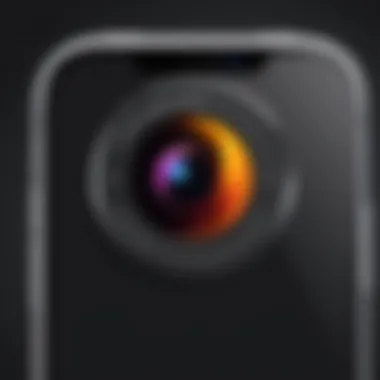
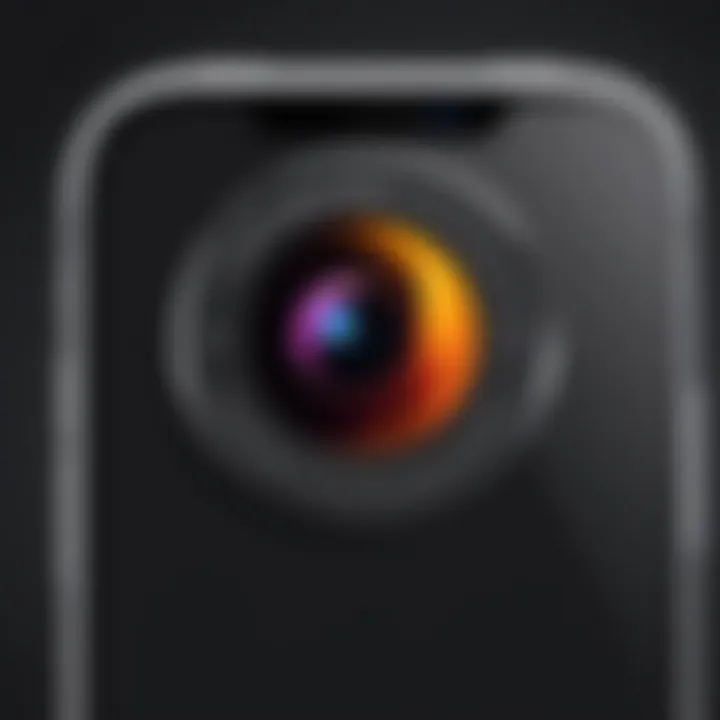
For many users, the camera settings might not be immediately clear. The iPhone’s interface can be overwhelming, especially for those who are not familiar with every option available. Users may find it hard to find the specific settings for red-eye reduction.
Here are some pointers to help in locating these settings:
- Open the Camera App: Start by unlocking your iPhone and tapping on the Camera app icon.
- Accessing Settings: Look for a small gear icon or the three horizontal lines that signify the settings menu. Tap it to access camera options.
- Seek the Flash Menu: Within the settings, tap on the flash icon. Here, the red-eye reduction option can sometimes be hidden among flash settings.
If the settings are still unclear, consider consulting the iPhone's user guide. Documentation can provide insights tailored to specific models, especially those that may differ in features.
Persisting Red Eye Phenomenon
Despite turning off red-eye reduction, some users may still notice red-eye in their images. This can be frustrating and may lead to further attempts to disable the feature. Several reasons may contribute to this issue.
- Lighting Conditions: Red-eye often occurs due to certain lighting. For example, when using a flash in low light, red-eye is more likely to happen. Ensuring adequate lighting before capturing photos can help mitigate this problem.
- Camera Angle and Subject Position: The angle at which the photo is taken and the subject's position can also affect red-eye occurrence. Encouraging subjects to look slightly away from the lens may reduce reflections from the flash.
- Software Bugs: There may be software bugs affecting the camera functionality. If red-eye persists, updating to the latest iOS version can help. Regular software updates can address bugs and enhance performance.
"Photography is about capturing moments - don't let red-eye undo your hard work."
Remember that technology varies between models, so it is beneficial to stay updated on your specific device's functionality. By keeping up with device updates and settings, you can maintain a seamless photographic process.
Alternatives to Red Eye Reduction
Red-eye reduction can sometimes fall short in effectively addressing the issue of red-eye in photographs. This may lead users to seek other methods for enhancing their images post-capture. Exploring alternatives is essential because it provides flexibility in photo editing and ensures more control over the artistic direction of images.
There are several paths available for users who want to enhance their selfies or group photos with minimal red-eye effect. These alternatives not only solve the immediate problem but can also improve overall photography skills.
Manual Editing Techniques
Manual editing techniques show significant promise when it comes to photo enhancement. When using the built-in Photos app on an iPhone, users can tackle red-eye issues with precision through simple edits:
- Open the Photo: Locate and open the desired photo in the Photos app.
- Edit: Tap the "Edit" option located at the top right of the screen.
- Select the Red Eye Tool: The red-eye correction tool can easily remove red-eye by selecting the affected area on the subject’s eyes.
- Adjust: Users can tweak further using brightness and sharpness to ensure the image appears natural post-editing.
- Save Changes: After adjustments, don't forget to save the changes made.
This process grants the user greater control over their images, allowing for meticulous refinements.
Utilizing Third-Party Applications
Third-party applications can complement the iPhone's built-in capabilities. Countless apps exist, each offering unique tools tailored for red-eye correction among other editing features. Some notable options include:
- Adobe Lightroom: Known for its advanced editing capabilities and user-friendly interface, this app allows users to perform detailed adjustments. Users can remove red-eye effectively and apply professional-grade edits to their photos.
- Snapseed: This application also provides a robust set of features for photo manipulation. Its Healing tool can help in fine-tuning red-eye issues while also enhancing the overall image quality.
- PicsArt: Offers various editing options, including stickers and effects. This is user-friendly and allows for simple yet effective red-eye removal.
Using third-party applications not only helps in altering just the red-eye issue but can enhance the overall photograph. Each application brings unique strengths that can cater to different preferences and editing styles.
"Removing red-eye is just the beginning. Embrace diverse editing tools to unlock the full potential of your photography."
Understand Post-Capture Modifications
When capturing images, the red-eye effect can occur even after taking measures during shooting. Therefore, understanding post-capture modifications holds significant importance. The ability to tweak and alter images after they have been taken can dramatically enhance visual quality, especially for pictures marred by red-eye anomalies.
Post-capture editing allows photographers to salvadge shots that may otherwise remain unusable, transforming frustrating outcomes into appealng visuals. Moreover, users can fine-tune various aspects such as brightness, contrast, and sharpness, all of which contribute to a more visually pleasing image.
Benefits of Post-Capture Modifications
- Enhanced Aesthetics: By adjusting color balance or exposure, the overall appearance of photographs improves. This is especially crucial for professional work.
- Correcting Errors: Mistakes during the photo-taking process can be mitigated effectively through editing.
- Creative Expression: Post-capture tools enable enhanced creativity, allowing users to apply different styles and filters.
- Saving Memorable Moments: Often, it is possible to rescue images that capture valuable memories but suffer from imperfections.
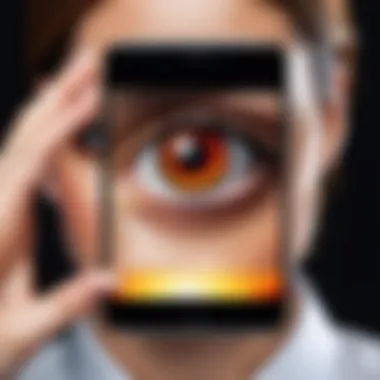
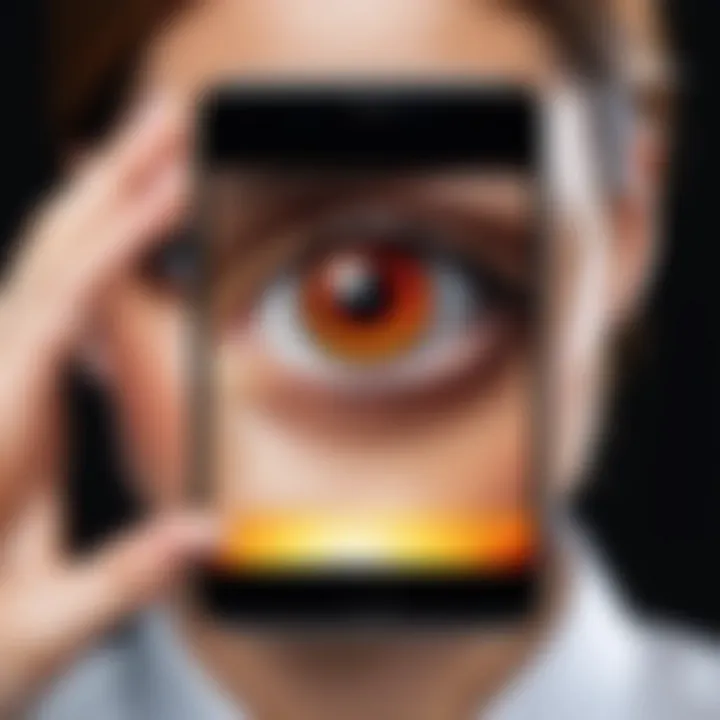
Understanding how to edit images directly on the device can streamline the process, making it easier for users to quickly rectify any issues. Thus, mastering post-capture modifications is essential for any user who seeks to refine their photographic outputs.
Editing Photos Directly on iPhone
The iPhone offers a robust set of built-in editing tools that users can take advantage of. Accessing these tools is simple. After taking a photo, tap on the thumbnail in the bottom-left corner of the camera app. This action brings you to the editing screen where multiple options are available.
Key features include:
- Auto-Enhance: A quick fix for improving photos with a single tap.
- Filters: Different styles can be applied to change the image's mood.
- Crop and Rotate: Useful for focusing on essential elements and altering framing.
- Adjust: Provide control over exposure, brightness, contrast, and saturation.
Utilizing these tools allows users to quickly rectify red-eye issues. Adjusting brightness or color settings can reduce the visibility of red eyes, often making them less noticeable.
Integrating Editing Tools
While the built-in options on the iPhone are useful, many users may want advanced capabilities. This can be achieved through third-party applications that can be installed from the App Store. These applications offer a varying range of features, some of which may not be available in the native app.
Popular photo editing tools include:
- Adobe Lightroom: Ideal for professional-grade editing, including color grading.
- Snapseed: Built by Google, it provides an array of filters and precise editing controls.
- VSCO: Known for its presets and simple interface, favored by many photographers.
- PicsArt: A versatile application combining photo and video editing features.
Integrating these tools into the workflow allows users to achieve their desired results more efficiently, ensuring that every photo reaches its full potential while minimizing the impact of red-eye effects.
"Post-capture modifications are not just about fixing mistakes; they are an opportunity for creative expression and personal storytelling."
Exploring Device Updates and Their Effects
In the realm of smartphone technology, device updates play a pivotal role in maintaining functionality, security, and performance. This section delves into how these updates influence the iPhone's camera features, particularly in relation to red-eye reduction. Understanding the implications of software updates is essential for users who wish to optimize their photography experience. Regular updates can introduce new settings, refine existing capabilities, and offer solutions to persistent issues. Therefore, keeping your iPhone's software up-to-date is not just a good practice but vital for ensuring an improved and hassle-free photography experience.
iOS Updates and Camera Features
With each iOS update, Apple often enhances the camera's capabilities, sometimes changing how features like red-eye reduction function. Users may notice tweaks in functionality or user interface changes that affect how they capture images. For instance, the introduction of machine learning processes has made some features more intuitive, automatically adjusting settings based on the context of the shot. These enhancements might not navigate explicitly to red-eye reduction, but they improve the overall image quality, potentially reducing the prevalence of red-eye in the first place.
Moreover, maintaining the latest iOS version can help in fixing glitches related to camera settings, including red-eye reduction failures. Users are encouraged to check for software updates regularly; these can typically be found by navigating to Settings > General > Software Update. Not only does this ensure access to the latest features, but also resolves previous bugs, making the camera more reliable.
User Feedback on Red Eye Reduction Adjustments
User feedback serves as a critical barometer for assessing the effectiveness of camera updates in the iPhone. Many users freely share their experiences via platforms such as Reddit or Facebook, noting whether new updates resolved historical issues related to red-eye reduction. Their insights can guide other users when evaluating the implications of newly introduced features or modifications.
For example, discussions may arise surrounding whether the adjustments to the red-eye reduction feature legitimately improved functionality or if it made navigating settings more cumbersome. Such feedback can highlight essential considerations:
- User Satisfaction: Are users generally satisfied with the improvements?
- Usability: Are features easier to access following an update?
- Functionality: Do changes lead to more reliable red-eye reduction, or do issues persist?
Adaptations that draw significant attention involve direct impact on user experience. If a particular iOS update significantly reduces instances of red-eye, users will likely express that sentiment, thus influencing others to embrace the update or remain skeptical. Keeping an eye on community feedback regarding updates can provide further clarity and informed decision-making for those who prioritize optimal camera performance.
Finale and Key Takeaways
Disabling the red-eye reduction feature on your iPhone is more than just a technical adjustment; it impacts the way you capture moments and express your creativity through photography. This article has outlined not only the practical steps for turning off the red-eye reduction but also the importance of understanding how the feature works and why it may be necessary to disable it in certain lighting conditions. By gaining insight into device settings and troubleshooting common issues, you place yourself in a better position to optimize your imaging experience.
Final Thoughts on Red Eye Management
Red eye can be a frustrating issue for photographers. While the red-eye reduction feature on iPhones aims to mitigate this effect, it is not always successful. Disabling this feature allows for greater control over your images and can yield more authentic representations of your subjects. Understanding when and how to manage red eye is essential, especially when shooting in environments with bright flash or unusual lighting. By considering manual editing techniques or using third-party applications, one can effectively eliminate red-eye problems with greater precision.
Encouragement for Experimentation
Experimentation is integral to developing one's skills in photography. With each new attempt, users learn how various settings and conditions affect their images. Turning off red-eye reduction may lead to unexpected challenges, but addressing these issues fosters growth and improvement. Don’t hesitate to make changes in your approach; capturing the right moment might sometimes require stepping out of your comfort zone. Ultimately, by refining your editing techniques and exploring new tools, you can discover unique ways to enhance your photographic style.
"Photography allows you to capture life’s moments as they are, and removing barriers like unwanted red eye can unleash your true potential as a photographer."
By fluidly adapting to changes and understanding your tools, you can create striking visuals that tell a story, all while maintaining the authenticity of your subjects.







